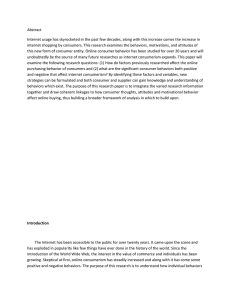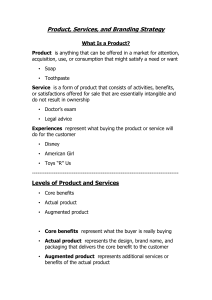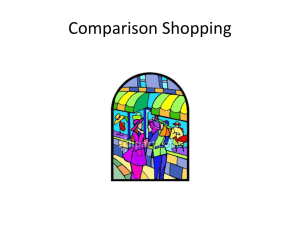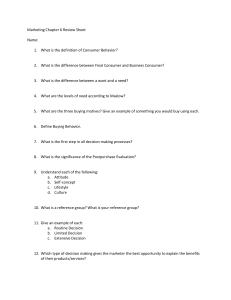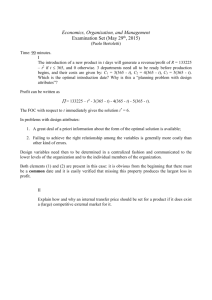Online Consumer Behaviors 1
advertisement
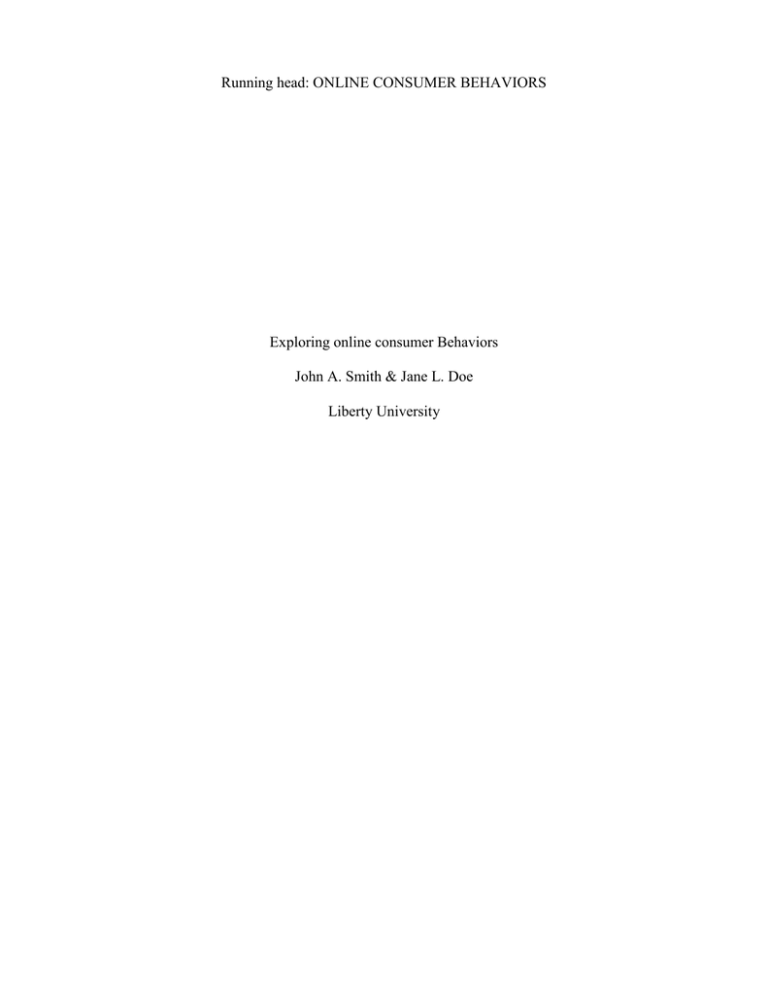
Running head: ONLINE CONSUMER BEHAVIORS Exploring online consumer Behaviors John A. Smith & Jane L. Doe Liberty University Abstract Internet usage has skyrocketed in the past few decades, along with this increase comes the increase in internet shopping by consumers. This research examines the behaviors, motivations, and attitudes of this new form of consumer entity. Online consumer behavior has been studied for over 20 years and will undoubtedly be the source of many future researches as internet consumerism expands. This paper will examine the following research questions: (1) How do factors previously researched affect the online purchasing behavior of consumers and (2) what are the significant consumer behaviors both positive and negative that affect internet consumerism? By identifying these factors and variables, new strategies can be formulated and both consumer and supplier can gain knowledge and understanding of behaviors which exist. The purpose of this research paper is to integrate the varied research information together and draw coherent linkages to how consumer thoughts, attitudes and motivational behavior affect online buying, thus building a broader framework of analysis in which to build upon. Introduction The Internet has been accessible to the public for over twenty years. It came upon the scene and has exploded in popularity like few things have ever done in the history of the world. Since the introduction of the World Wide Web, the interest in the value of commerce and individuals has been growing. Skeptical at first, online consumerism has steadily increased and along with it has come some positive and negative behaviors. The purpose of this research is to understand how individual behaviors affect online consumerism. According to Lars Perner, consumer behavior is defined as “the study of individuals, groups, or organizations and the processes they use to select, secure, use, and dispose of products, services, experiences, or ideas to satisfy needs and the impacts that these processes have on the consumer and society” (2008). By identifying the behaviors that support buying online and those which do not, businesses can help to increase profits and will help to assure their share of the market, as electronic trade may well out-step traditional buying in the not to distant future. There are many variables to consider when outlining behaviors of Internet consumerism. According to Delia Vazquez and Xingang XU, online consumer behavior is affected by three main things: “attitudes towards online shopping, motivations, such as price, convenience and hedonic motivations, and online information search” (2009, p.409). If a person is positive about the experience of shopping on the Internet then that attitude will affect the outcome of purchasing online. Also online consumers feel more in control when they can search with relative ease, prices and special offers. This price comparison is in itself, a great motivational tool. The fact that more information is available online concerning products also allows the consumer to feel that better information, will lead to better decision making on their part. Research was conducted through a self-given online questionnaire. Important data was collected concerning the scale items of attitude, motivations and searches of information. The group consisted of students in three different age categories. The first were between 15 and 24. The second group was between 25-34 years old. The last group fell between the ages of 35 and 44. The 35-44 year old group was rated as first in Internet buying. The 25-30 year olds were next, followed by the younger group. A further study was done through the use of email and administered questionnaires. Two hundred students were surveyed in person and 300 students were asked to fill in an email survey. Between the two groups, 406 responded and participated in the research. Data analysis using a quantitative approach was used. Reliability analysis was formulated and used to test the data obtained. Canonical analysis was also used to help understand the data and build a framework around online consumer behavior. The analysis showed that 49.8% of those surveyed were women and 50% were male. The group under age 24 made up a little less than two thirds of the total. Those over 24 accounted for the rest. Respondents who had used the Internet for five years or more represented 79% of the study. The results clearly showed that online shopping motivations, information searches, and attitude all had a significant affect on online purchases. Other variables to consider in online consumer behavior are online experience, sexual preference, and the primary place in which the Internet is accessed. In a study performed by Cuneyt Koyuncu and Donald Lien, research showed that all three of these had “large statistically significant effects on online shopping” (2003, p.721). They concluded that consumers, who had more experience with the internet, felt more comfortable navigating it. Consumers also felt safer in using the internet at their residence or on the job, rather than community computers. Sexual preference, according to their research, showed that bisexuals bought online in greater numbers than heterosexuals. This behavior may have resulted because of the bias against this portion of the population that is present in society. The survey which supports this data was conducted by Georgia Institute of Technology. There were over 10,000 participants. The total amount of samples used was 8717. Data such as an individual’s demographic; economics, sexual preferences, and primary places of online access were collected. The findings showed 7026 considered themselves online shoppers, while 1691 did not. The average for education was considered, “some college” for both groups. Online shoppers’ income was between $50 and $74K. The non-online shoppers’ income was between $30 and $40K. The average ages of both groups were between 36 and 40 years old. Almost 90% were white and 60% were male. A little under half of all the participants were married. The conclusion of this research clearly identified that both the primary place to access the Internet and sexual preference had very important positive effects on online shopping. Unlike shopping in a store on-site, making purchases online has other positives associated with it. According to Anthony Ammeter and Donghyun Kim, they stated “one of the most important traits of online shopping is bidirectional communication capability” (2008, p.9). They go on further to explain how online shoppers have greater assess to communicate with those they are buying from. This communication can take place in such ways as bulletin boards and e-mails. This gives consumers a perception of personalized assistance. In contrast to this scenario, is the fact that we are losing our ability to maintain a high level of customer service on-site. The employees many shoppers encounter seem more to be filling a spot than actively engaging in helping consumers with purchases or becoming knowledgeable about what they sell. Online consumerism is not however without its apprehensions. Set forth in the research by Janda Swinder were concerns. She stated in her article that there were, “four consumer online concerns, identified as privacy, security, credibility, and virtual experience” (2008, p. 339). Each of these factors is considered when people think of making online purchases. Privacy issues, security, credibility and virtual experience have all shown to have negative effects on consumer purchasing. It is relatively simple for information to be collected from consumers whenever one logs onto a site or makes a purchase. Some information, such as name, address, phone number and credit card, is gathered through direct questioning and other information is gathered through tracking software. This transference of information makes some consumers nervous and they do not want to take the risk. Another point to consider is the credibility of the person or business in which one is dealing with. Questions arise about trust, description of merchandise, warranties, shipment, returns, and follow-up correspondence. Although this concern, though valid, has according to research, had very limited negative effect on consumer buying habits (2008). Another negative behavioral pattern well documented is that of compulsive buying tendencies. These tendencies to over buy can have detrimental affects on the consumer, notably affecting monies, feelings, and relationships. According to “The Relationship Between Consumers’ Tendencies to Buy Compulsively and Their Motivation to Shop and Buy on the Internet,” somewhere between 5 and 9 percent of America’s population could be identified as people who have a propensity to compulsively buy (Kukar-Kinney, Ridgway, and Monroe, 2009). Motivators of this type of behavior include the very key ingredients of online shopping. These motivations are the following; items may be purchased at any time, shopping can be done frequently, a broader variety exists, and also purchases may be brought in private. The actual detailed research conducted involved many aspects. The first method of research was a survey of over 300 people in 42 states. As quoted from the article, “the sample consisted of 98.5% women, 63% of the respondents were married, the average age was 53 years, and the average household income was $82,000” (2009, p.300). The penchant to buy compulsively was measured using a buying scale that included six focuses. These scale items included, unopened packages at home, labeled by others as a shopaholic, how much time actually spent shopping, buying unneeded items, buying unplanned items, and if the surveyed considered themselves an impulse buyer. Research was also conducted using a 22 statement survey in which the surveyed agreed or disagreed with the following statement, “In comparison to retail stores, I shop on the Internet when buying clothing and accessories for myself because” (2009, p.301). The 22 statements included areas that linked to, “buying unobserved, product variety, social interaction, and immediate positive feelings.” An analyses of the information was obtained through a series of “linear regression analysis, with individual shopping and buying motivations in the role of the dependent variable, and compulsive buying index as an independent variable” (2009, p.302). The final research was defined as cluster analysis. Taken into account were such categories as demographics, age, gender, income, education level, marital status, average income spent at retail and internet stores, frequency of purchase, and the number of credit cards used. All of this research data was well defined and explained. The findings of each method was then charted and analyzed with easy to understand tables and terminology. In keeping with the theme of the method section, the interpretations and conclusions made by these researchers were very detailed and data supported. The results showed that compulsive online consumer behavior was in part explained by motivations of the shopper. All motives set forth in this study exhibited an important positive connection to the compulsive buying scale except for one and that was the product variety motive. The overall findings concluded, as the researchers had hypothesized that compulsive buying strongly affected consumers’ decisions to make purchases using the Internet. This research group acknowledges that one of its weaknesses was the sampling of consumers used. Subjects were relatively wealthy women, who frequented expensive internet retailers. I believe, as they do, that this assessment represents a bias in the general population. The research also only tracked the behavior of women. Compulsive online consumer behaviors are not gender specific and therefore this research, in my opinion, is somewhat flawed. Another weakness noted in this study was the amount of people surveyed in the first example with a total number of a little over 300. I do however think that one of this study’s greatest strengths was the broad base of surveys conducted (2009). There are differences in online behaviors as identified by gender in the research of Janda (2008). Main differences account for shopping behaviors, attitudes to technology, and processing of information. Women were found to be more venerable to risks and perceived risks as higher than that of the male population. It was also found that women used the Internet less often and were less confident about their online ability. Females were found to enjoy the experience of shopping more than men. Women leaned more toward the sites which provided information and education about items. The data for this gender research was gathered through surveys that were handed out. The opinions were taken from a quota sampling of different age groups. Responses totaling 404 were collected. The sample included a total of 196 men and 208 women. The median age was 32.8 years old. Another noted point was that the participants each had a history of Internet usage for about five years(2008). This is valuable research and asserts that these differences must be addressed in order for online distributors to appeal to both sexes in a meaningful way. In research done by Christy Crutsinger, Sua Jeon, and Haejung Kim, they identified seven motivators of online auction participants. These motivators were, “search costs, product assortment and price, brand equity, transaction costs, customer orientation, perceived quality, and social interaction” (2008, p.31). Never before has there been such a vehicle for buying and selling merchandise and services. Online auctions are tapping into this relatively new trend. More than 1,660 sites have been procured and are available to cater to this type of consumer. The study on online auctions was done through a questionnaire, based on 36 auction motivators, online behavior, and demographics of participants. The Likert scale was used to determine responses. These participants totaled 410 and were selected from a pool of college students. Data was retrieved from 341 responses. There were 74.8% female and 42.6% labeled as white. The ages ranged from 18 to 40 years old. The collected data revealed 90.9% were regular users of the Internet. A low 20% revealed they had no online auction experience. The remaining who did have experience with online auctions were identified as follows; 5.3% used the Internet daily, 15.2% weekly, 29.9% monthly, and 29.3% said one to two times per year. An interesting note to this research was that although most of those surveyed had participated in online auctions, the majority of them (80.6%) conveyed that they had never sold anything online. According to this research the following results showed that, “search costs were the most important motivation, followed by product assortment/price, brand equity, transaction costs, customer orientation, and perceived quality. Social interaction was the least important motivation associated with online auction behaviors” (2008, p. 36). There is no doubt that college students are very involved Internet participants. Studies like this one show the need for businesses to see the value of online auctions and use this prospect to increase their customer base. This research, however did not addressed the negative component of online auction consumer behavior. These types of behavior may fall into one of two categories, such as impulse buying or compulsive buying. Further research would need to be done in order to fully understand online consumer auction behavior. A major part of esthetics is how information is arranged on the web page. Too much information can overwhelm a consumer, too little can decrease consumer confidence. J.M. Stibel conducted research which included this topic of interest. Tests performed by him showed how online information presentation failed in many ways. His results showed clearly that “category information presented in an alphabetical list allowed consumers the ability to navigate to their destination much faster than when they were asked to traverse a hyperlinked hierarchy” (2005, p. 149). Simplicity is the key. Consumers want to navigate with the least amount of effort. Clarity in the web design gives consumers the confidence in their ability to do so. This research led Stibel to identify a mental model of consumers, which concluded that people wanted information presented in concise and understanding ways. The ability of online businesses to do this is imperative because it leads to a “more intuitive and compelling online experience (2005, p.149). There is a sub-group of online consumers that have been recently identified. This group has been termed, the “net-geners or net generation.” This term is defined as, “individuals born between 1977 and 1997 and is the first generation to grow up surrounded by digital media and the Internet” (Donghyun Kim & Anthony Ammeter 2008, p.7). This group understands technology and is comfortable with Internet commerce. The net-geners are the first generation that will actually surpass the baby-boomers in population size. Because of their knowledge and their numbers, it is safe to say that business as usual is in for a transformation. As the elderly portion of our population die and new individuals are born, this new way of doing business will be the reality that is known throughout life. The sky is indeed the limit in the progression of online consumerism. Method Reference Page Crutsinger, Christy. Jeon, Sua & Haejung, Kim. (2008). Exploring online auction behaviors and motivations. Journal of Family and Consumer Sciences, 100(2), 31-40. Janda, Swinder. (2008) Does gender moderate the effect of online concerns on purchase likelihood? Journal of Internet Commerce, 7(3), 339-357. Koyuncu, Cuneyt & Lien, Donald. (2003). E-commerce and consumer’s purchasing behavior. Applied Economics, 35, 721-726. Kukar-Kinney, M., Ridgway, N. & Monroe, K. (2009). The relationship between consumers’ tendencies to buy compulsively and their motivations to shop and buy on the internet. Journal of Retailing: Consumer Behavior and Retailing, 85(3), 298-307. Stibel, J. M. (2005). Mental models and online consumer behavior. Behavior & Information Technology, 24(2), 147-150. Retrieved from Vazquez, Delia. & Xu, Xingang. (2009). Investigation linkages between online purchase behavior variables. International Journal of Retail & Distribution Management, 37(5), 408-419.
